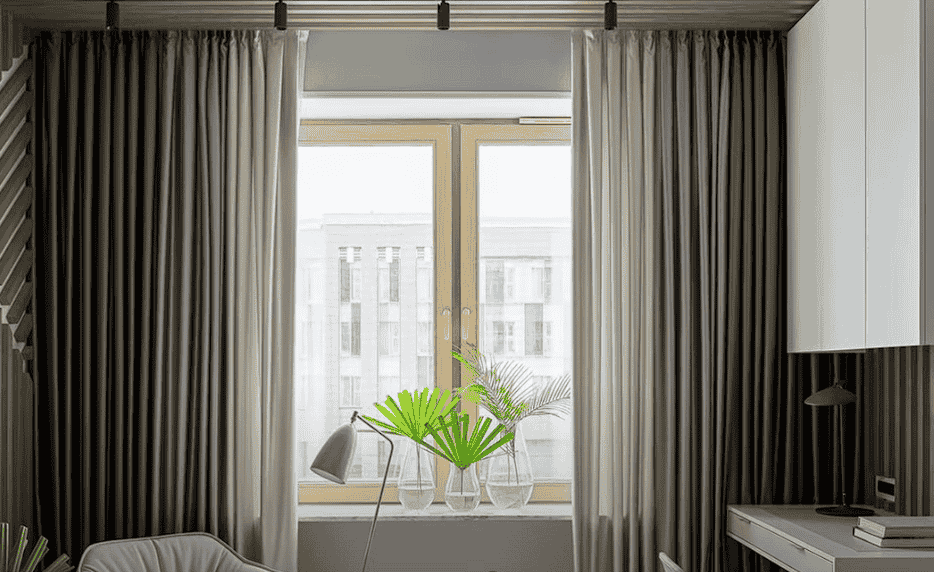Sunlight streaming into your home can be beautiful, but too much exposure can lead to faded furniture, increased room temperature, and even discomfort. The right curtains can help block harmful UV rays, keep your space cool, and reduce energy costs. But which curtain material is best for sun protection?
If you’re looking for the perfect sun-blocking curtains, this guide will help you choose the best fabrics, features to consider, and the top materials available.
Related post: Curtain Ideas for Drawing room
Why Sun Protection Curtains Material Are Important
Before we learn about the best curtain material, let’s understand why sunscreen curtains are important to us. These curtains not only enhance the beauty of your home but also offer many practical benefits:
✔ UV Protection – The sun’s harmful rays can fade the color of your furniture, floors, and walls. Sunscreen curtains block these rays to keep your home furnishings looking new and protected for a longer period.
✔ Temperature Control – In summers, these curtains prevent the sun’s heat from coming in, keeping the room cool. In winters, they trap the heat inside and keep the room warm.
✔ Energy Efficiency – When a room is protected from heat or cold, the use of air conditioners or heaters is reduced. This reduces electricity bills and saves energy.
✔ Glare Reduction – Bright sunlight can make watching TV, working on the computer, or reading difficult. These curtains soften the sunlight and relax the eyes and make these activities easier.
Key Factors to Consider When Choosing Sun Protection Curtain Material
Remember these factors while selecting your sunscreen curtains.
Opacity.
A thicker curtain fabric with high density ensures better sunlight blocking. To block light from coming in, opt for tightly woven or a selection of multi-layered fabrics. This will help keep your room cool.
Fabric type.
Some materials offer better sun protection than others. For example, you can use fabrics like cotton or polyester. We’ll learn more about the best options below.

Lining and backing.
Thermal or blackout lining curtains provide better sun protection. Curtains with a white backing or reflective backing help keep out heat and keep cool.
Color.
Curtains with dark colors absorb sunlight and won’t let it in. But light colors with reflective backings can be effective as they too repel heat back.
Weave and Thickness.
When you have multiple layers of fabric with a tight weave, they block more light. Loosely woven fabrics let in more light, so avoid them.
By factoring this in, you can opt for curtains that not only enhance the aesthetic of your space but also protect against sunlight and heat. The perfect curtains will help make your home comfortable, stylish, and energy efficient!
Best Curtain Materials for Sun Protection
1. Blackout Curtains (Triple-Weave Polyester or Polyester Blends)
✪ Best for Maximum Sun Blocking
Blackout curtains are made with a triple-weave fabric that includes a dense inner layer designed to block 95-100% of sunlight. Polyester curtain material is the most common fabric used in blackout curtains due to its durability and high-density weave.

✪ Best for Maximum Sunlight Blockage
Blackout curtains are designed to block out almost all sunlight. These curtain materials are made of triple-weave fabric, which has a dense inner layer that prevents light from entering.
Polyester is the most common material for this type of curtains because it’s durable and has a tight weave.
Pros:
✔ Blocks out 95-100% of sunlight making the room completely dark.
✔ Reduces heat and noise, keeps the room cool and quiet.
✔ Affordable and available in the market.
Cons:
✘ Heavy so it takes some effort to open and close them.
✘ Low breathability makes the room feel a bit enclosed.
Best for: Bedrooms, home theaters, nurseries where complete darkness is required.
2. Thermal Insulated Curtains (Polyester with Foam Backing or Thermal Lining Curtain Material)
✪ Best for Sun Protection & Energy Efficiency
Thermal curtain materials are best for sun protection and energy efficiency. They are like blackout curtains but with an extra layer of insulation that prevents heat from escaping. These curtains block the sun and regulate the room temperature.

Pros:
✔ Block UV rays and heat, cool the room.
✔ Save energy, less use of aircon and heater.
✔ Various designs and colors available.
Cons:
✘ A bit more expensive than blackout curtains.
✘ May need additional lining for total darkness.
Best For: Living rooms, offices, homes in extreme climates
3. Velvet Curtains
✪ Best for Luxurious Sun Protection
Velvet is thick and tightly woven fabric curtain material that naturally blocks sunlight. Its plush texture adds a touch of luxury while keeping your space cool.

Pros:
✔ Naturally heavy and opaque
✔ Provides excellent insulation
✔ Enhances room aesthetics
Cons:
✘ Expensive
✘ Requires special care and cleaning
Best For: Formal spaces, bedrooms, theaters
4. Linen Curtains with Blackout Lining
✪ Best for Breathability & Sun Blocking
While linen is, by its nature, a lightweight and semi-sheer fabric, when it is lined with a blackout, it makes the best sun-protective fabric curtain material. It has a natural, airy look without sacrificing functionality.

Pros:
✔ Stylish and breathable
✔ Shields light with a blackout lining
✔ Ideal for warm climates
Cons:
✘ Can wrinkle easily
✘ More expensive than synthetic fabrics
Best For: Living rooms, kitchens, modern interiors
5. Acrylic-Coated or Rubber-Backed Curtain Material
✪ Best for Reflecting Heat & UV Rays
Curtain material with an acrylic or rubber backing offers one of the highest levels of sun protection. These coatings reflect sunlight away from the home while keeping interiors cool.

Pros:
✔ Superior heat and UV protection
✔ Reduces energy costs
✔ Durable and long-lasting
Cons:
✘ Can have a plastic-like appearance
✘ Limited color and style options
Best For: Sunrooms, conservatories, large windows facing direct sunlight
What kind of curtains block sunlight?
If you can cover them with curtains, they block most of the sun’s rays. Curtains come in various forms: fabric, vinyl, bamboo, and even plastic curtains, to name a few. Each material has advantages and disadvantages, which we will review here.
Fabric Curtains
Curtains made of textiles have been around since time immemorial. Although they are durable and affordable, they offer little protection from the harmful ultraviolet rays of the sun. When you need something simple and inexpensive for a small space, fabric curtains are better.
Vinyl Curtains
Vinyl curtains are a bit more expensive than fabric curtains, but they’re still cheaper than buying a whole window treatment kit. Vinyl curtains are made from polyvinyl chloride (PVC) and are resistant to fading and mildew. Additionally, they are simpler to clean than fabric curtains.
Bamboo Curtains
Bamboo curtains are becoming increasingly popular. They are durable, light, and good for the environment. Bamboo fiber, which is naturally antibacterial and antifungal, is used to make bamboo curtains. They are also extremely long-lasting and hypoallergenic.
Plastic Curtains
In greenhouses and other enclosed spaces, plastic curtains are frequently utilized. In addition to being reasonably priced, plastic curtains are also simple to set up and take down. Additionally, they are extremely resistant to mildew and mold. Plastic curtains, on the other hand, won’t help your plants stay healthy because they don’t block UV rays.

Pingback: How to Wash Curtains with Rings in the Washing Machine
Pingback: Creative Ways to Hang Curtains Without Rods - 12 Easy Method